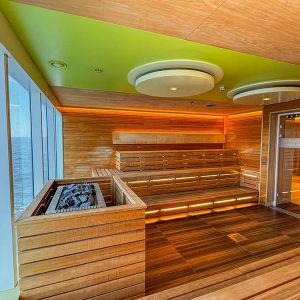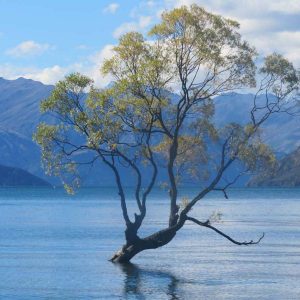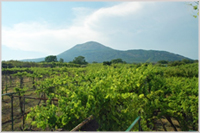 In AD 79 Vesuvius was a deadly enemy to the inhabitants of neighbouring towns and villages in the Gulf of Naples, and it may be so again. However before that eruption it appeared benign, its lower slopes producing luxuriant crops of olives and grapes, benefitting from the easily available nutrients of the volcanic soil left by an eruption 2000 years earlier. Today, after a similar time period, the Sorrentino’s family vineyard produces a range of fine wines which reflect the character of this unique combination of soil and microclimate.
In AD 79 Vesuvius was a deadly enemy to the inhabitants of neighbouring towns and villages in the Gulf of Naples, and it may be so again. However before that eruption it appeared benign, its lower slopes producing luxuriant crops of olives and grapes, benefitting from the easily available nutrients of the volcanic soil left by an eruption 2000 years earlier. Today, after a similar time period, the Sorrentino’s family vineyard produces a range of fine wines which reflect the character of this unique combination of soil and microclimate.
In June 2014, I visited this 200 year old winery as part of a tour organised by the Naples Chamber of Commerce. Near the south-east end of the bay of Naples, the scenic 62.5 hectare vineyard climbs to 600m on the foot of Vesuvius, where the oldest vines are found. As explained by family member Maria Paola Sorrentino and guide Mattia Buodonno, here in the lower temperatures and cloudier conditions, maturation is slower and the harvest later, with grape yields only around 2/3 of the maximum obtained lower down. The oldest vines are trained in the traditional system over a horizontal framework, while lower down a vertical type if training is being tried, to allow more light to the lower leaves. All production is organic, and we were shown an interesting system of integrated production in which the vines are intercropped with vegetables such as tomato, aubergine, courgette, peppers, pumpkin and beans. 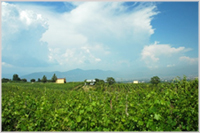 The vegetable soil is fertilised only by horse manure, from which the neighbouring vines are able to derive sufficient additional nutrition.
The vegetable soil is fertilised only by horse manure, from which the neighbouring vines are able to derive sufficient additional nutrition.
The highlight of the visit was, of course, the tasting of the product! Our wines came from the ‘Lacryma Christi del Vesuvio’ selection – from the legend that Lucifer, when chased out of Heaven, stole part of it and deposited it in the Gulf of Naples. Christ, sad to have lost a so beautiful part of Heaven, started to cry and, there where his tears fell, the grapevines miraculously rose. The wine obtained from these grapevines was called ‘Tears of Christ’.
The first sampled was labelled ‘Dorè, Lacryma Christi del Vesuvio’, a delicious medium-dry sparkling creamy white made from 80% Coda di Volpe and 20% Falanghina varieties; with pear and perhaps slight pineapple flavours. This was followed by a light rosé – ‘Lacryma Christi del Vesuvio Rosata’, with 90% Piedirosso and 10% Aglianico grapes. 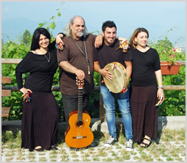 Finally, perhaps the most characteristic of all, came the ‘Lacryma Christi Rosso selezione vigna Lapillo’. The Piedirosso (80%) and Aglianico (20%) grapes used come from the highest and rockiest part of the vineyard where the soil contains small stones or ‘lapilli’, and produce a full bodied but fruity wine with plum and red fruit flavours and soft tannins. During our tasting we were extremely lucky to be entertained by guitarist and composer Giovanni D’Angelo from Ercolano, and his highly talented trio, performing beautiful songs and dances by Giovanni or from local tradition.
Finally, perhaps the most characteristic of all, came the ‘Lacryma Christi Rosso selezione vigna Lapillo’. The Piedirosso (80%) and Aglianico (20%) grapes used come from the highest and rockiest part of the vineyard where the soil contains small stones or ‘lapilli’, and produce a full bodied but fruity wine with plum and red fruit flavours and soft tannins. During our tasting we were extremely lucky to be entertained by guitarist and composer Giovanni D’Angelo from Ercolano, and his highly talented trio, performing beautiful songs and dances by Giovanni or from local tradition.
I would strongly recommend any wine lover visiting the Bay of Naples to consider a tour of the Sorrentino winery – Maria tells me that individuals or groups can arrange this by emailing turismo@sorrentinovini.com. I’m now trying to source these wines in the UK, in the hope that they might invoke the warm dappled sunlight beneath the Vesuvian vines.

